

Compact Muon Solenoid
LHC, CERN
| CMS-HIG-18-026 ; CERN-EP-2024-028 | ||
| Search for the decay of the Higgs boson to a pair of light pseudoscalar bosons in the final state with four bottom quarks in proton-proton collisions at $ \sqrt{s} = $ 13 TeV | ||
| CMS Collaboration | ||
| 15 March 2024 | ||
| JHEP 06 (2024) 097 | ||
| Abstract: A search is presented for the decay of the 125 GeV Higgs boson (H) to a pair of new light pseudoscalar bosons ($ \mathrm{a} $), followed by the prompt decay of each a boson to a bottom quark-antiquark pair, $ \mathrm{H}\to\mathrm{a}\mathrm{a}\to\mathrm{b}\bar{\mathrm{b}}\mathrm{b}\bar{\mathrm{b}} $. The analysis is performed using a data sample of proton-proton collisions collected with the CMS detector at a center-of-mass energy of 13 TeV, corresponding to an integrated luminosity of 138 fb$^{-1}$. To reduce the background from standard model processes, the search requires the Higgs boson to be produced in association with a leptonically decaying W or Z boson. The analysis probes the production of new light bosons in a 15 $ < m_{\mathrm{a}} < $ 60 GeV mass range. Assuming the standard model predictions for the Higgs boson production cross sections for pp $\to$ WH and ZH, model independent upper limits at 95% confidence level are derived for the branching fraction $ \mathcal{B}(\mathrm{H}\to\mathrm{a}\mathrm{a}\to\mathrm{b}\bar{\mathrm{b}}\mathrm{b}\bar{\mathrm{b}}) $. The combined WH and ZH observed upper limit on the branching fraction ranges from 1.10 for $ m_{\mathrm{a}} = $ 20 GeV to 0.36 for $ m_{\mathrm{a}} = $ 60 GeV, complementing other measurements in the $ \mu\mu\tau\tau $, $ \tau\tau\tau\tau $ and $ \mathrm{b}\mathrm{b}\ell\ell $ ($ \ell=\mu$, $\tau $) channels. | ||
| Links: e-print arXiv:2403.10341 [hep-ex] (PDF) ; CDS record ; inSPIRE record ; HepData record ; CADI line (restricted) ; | ||
| Figures | |
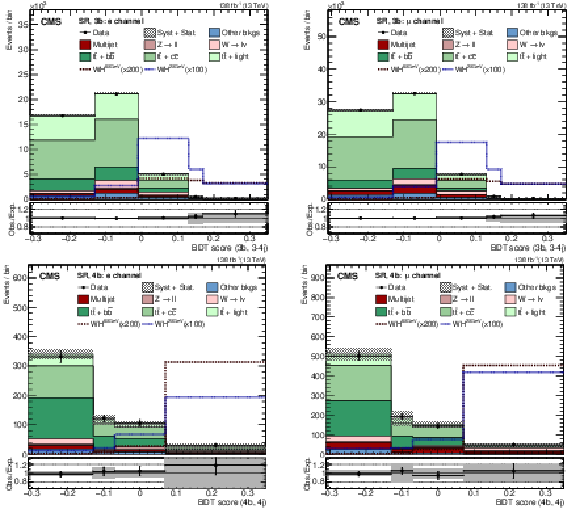
png pdf |
Figure 1:
Post-fit BDT distributions in the WH channel extracted with the $ m_{\mathrm{a}}= $ 60 GeV signal hypothesis. Signal regions for the 3b (upper) and 4b (lower) event categories are shown separately for the electron (left) and muon (right) channels. The dotted lines $ \mathrm{W}\mathrm{H}^{20\,\text{GeV}} $, $ \mathrm{W}\mathrm{H}^{60\,\text{GeV}} $, illustrate the shapes of the signal template normalised to the SM cross section times a branching fraction $ \mathcal{B}(\mathrm{H}\to\mathrm{a}\mathrm{a}\to\mathrm{b}\bar{\mathrm{b}}\mathrm{b}\bar{\mathrm{b}}) = $ 1 and scaled by the factors indicated in the figure. The horizontal error bars indicate the bin width. |
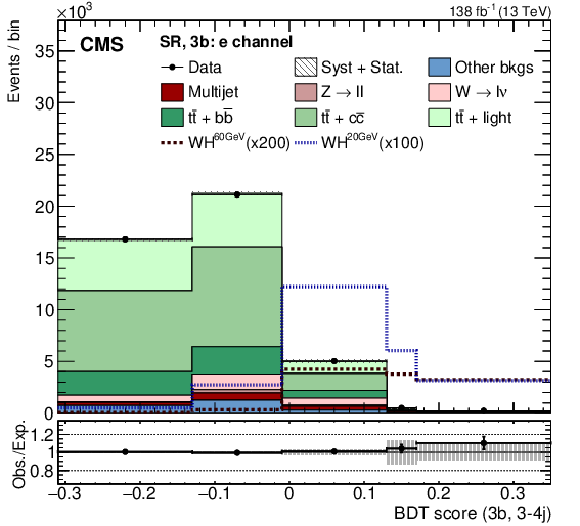
png pdf |
Figure 1-a:
Post-fit BDT distributions in the WH channel extracted with the $ m_{\mathrm{a}}= $ 60 GeV signal hypothesis. Signal regions for the 3b (upper) and 4b (lower) event categories are shown separately for the electron (left) and muon (right) channels. The dotted lines $ \mathrm{W}\mathrm{H}^{20\,\text{GeV}} $, $ \mathrm{W}\mathrm{H}^{60\,\text{GeV}} $, illustrate the shapes of the signal template normalised to the SM cross section times a branching fraction $ \mathcal{B}(\mathrm{H}\to\mathrm{a}\mathrm{a}\to\mathrm{b}\bar{\mathrm{b}}\mathrm{b}\bar{\mathrm{b}}) = $ 1 and scaled by the factors indicated in the figure. The horizontal error bars indicate the bin width. |
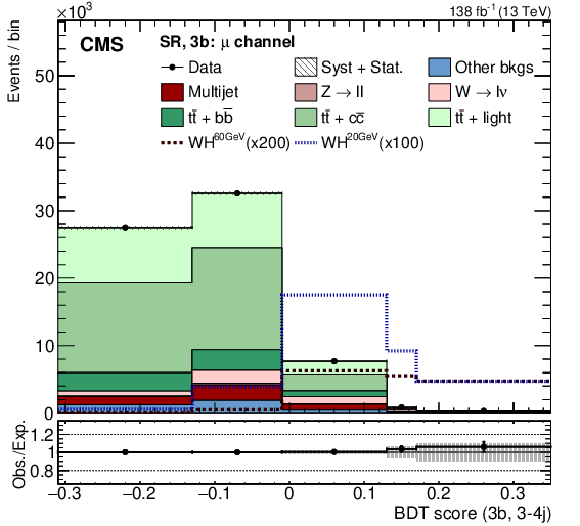
png pdf |
Figure 1-b:
Post-fit BDT distributions in the WH channel extracted with the $ m_{\mathrm{a}}= $ 60 GeV signal hypothesis. Signal regions for the 3b (upper) and 4b (lower) event categories are shown separately for the electron (left) and muon (right) channels. The dotted lines $ \mathrm{W}\mathrm{H}^{20\,\text{GeV}} $, $ \mathrm{W}\mathrm{H}^{60\,\text{GeV}} $, illustrate the shapes of the signal template normalised to the SM cross section times a branching fraction $ \mathcal{B}(\mathrm{H}\to\mathrm{a}\mathrm{a}\to\mathrm{b}\bar{\mathrm{b}}\mathrm{b}\bar{\mathrm{b}}) = $ 1 and scaled by the factors indicated in the figure. The horizontal error bars indicate the bin width. |
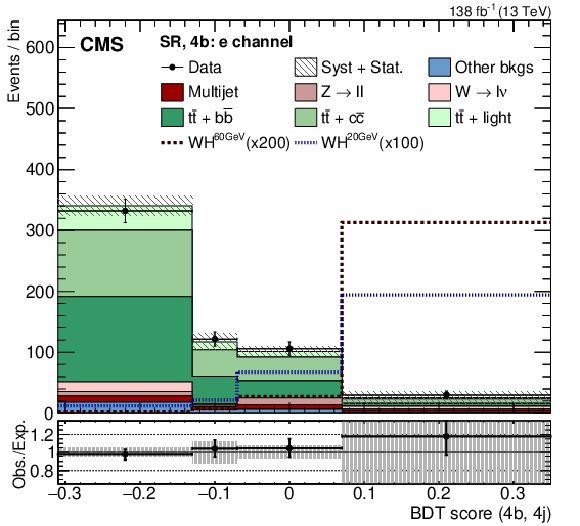
png pdf |
Figure 1-c:
Post-fit BDT distributions in the WH channel extracted with the $ m_{\mathrm{a}}= $ 60 GeV signal hypothesis. Signal regions for the 3b (upper) and 4b (lower) event categories are shown separately for the electron (left) and muon (right) channels. The dotted lines $ \mathrm{W}\mathrm{H}^{20\,\text{GeV}} $, $ \mathrm{W}\mathrm{H}^{60\,\text{GeV}} $, illustrate the shapes of the signal template normalised to the SM cross section times a branching fraction $ \mathcal{B}(\mathrm{H}\to\mathrm{a}\mathrm{a}\to\mathrm{b}\bar{\mathrm{b}}\mathrm{b}\bar{\mathrm{b}}) = $ 1 and scaled by the factors indicated in the figure. The horizontal error bars indicate the bin width. |
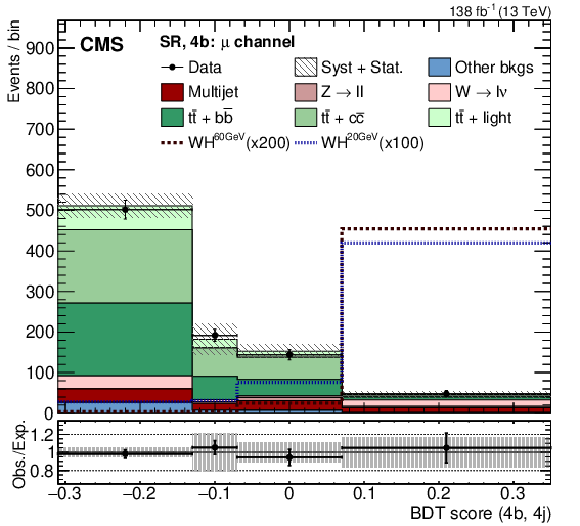
png pdf |
Figure 1-d:
Post-fit BDT distributions in the WH channel extracted with the $ m_{\mathrm{a}}= $ 60 GeV signal hypothesis. Signal regions for the 3b (upper) and 4b (lower) event categories are shown separately for the electron (left) and muon (right) channels. The dotted lines $ \mathrm{W}\mathrm{H}^{20\,\text{GeV}} $, $ \mathrm{W}\mathrm{H}^{60\,\text{GeV}} $, illustrate the shapes of the signal template normalised to the SM cross section times a branching fraction $ \mathcal{B}(\mathrm{H}\to\mathrm{a}\mathrm{a}\to\mathrm{b}\bar{\mathrm{b}}\mathrm{b}\bar{\mathrm{b}}) = $ 1 and scaled by the factors indicated in the figure. The horizontal error bars indicate the bin width. |
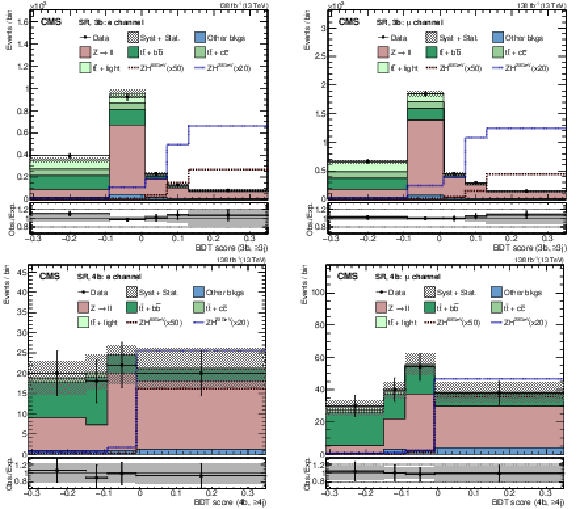
png pdf |
Figure 2:
Post-fit BDT distributions in the ZH channel extracted with the $ m_{\mathrm{a}}= $ 60 GeV signal hypothesis. Signal regions for the 3b (upper) and 4b (lower) event categories are shown separately for the electron (left) and muon (right) channels. The dotted lines $ \mathrm{Z}\mathrm{H}^{20\,\text{GeV}} $ and $ \mathrm{Z}\mathrm{H}^{60\,\text{GeV}} $, illustrate the shapes of the signal template normalised to the SM cross section times a branching fraction $ \mathcal{B}(\mathrm{H}\to\mathrm{a}\mathrm{a}\to\mathrm{b}\bar{\mathrm{b}}\mathrm{b}\bar{\mathrm{b}}) = $ 1 and scaled by the factors indicated in the figure. The horizontal error bars indicate the bin width. |
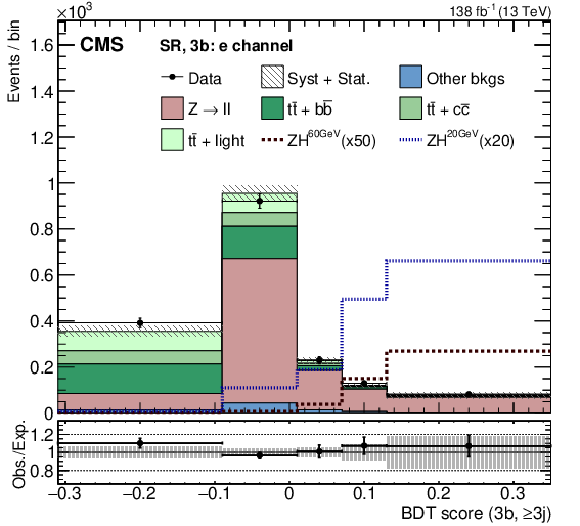
png pdf |
Figure 2-a:
Post-fit BDT distributions in the ZH channel extracted with the $ m_{\mathrm{a}}= $ 60 GeV signal hypothesis. Signal regions for the 3b (upper) and 4b (lower) event categories are shown separately for the electron (left) and muon (right) channels. The dotted lines $ \mathrm{Z}\mathrm{H}^{20\,\text{GeV}} $ and $ \mathrm{Z}\mathrm{H}^{60\,\text{GeV}} $, illustrate the shapes of the signal template normalised to the SM cross section times a branching fraction $ \mathcal{B}(\mathrm{H}\to\mathrm{a}\mathrm{a}\to\mathrm{b}\bar{\mathrm{b}}\mathrm{b}\bar{\mathrm{b}}) = $ 1 and scaled by the factors indicated in the figure. The horizontal error bars indicate the bin width. |
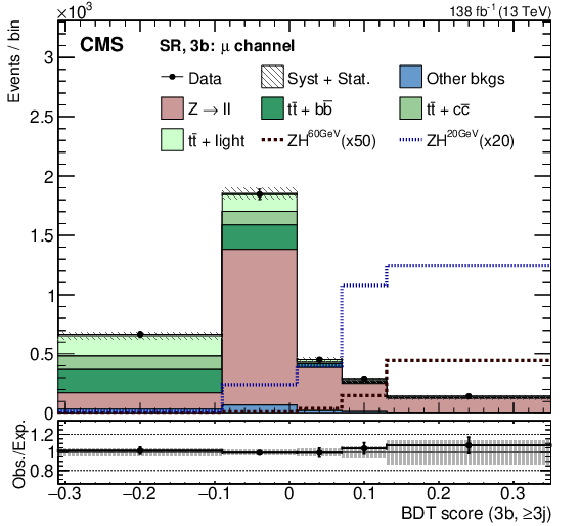
png pdf |
Figure 2-b:
Post-fit BDT distributions in the ZH channel extracted with the $ m_{\mathrm{a}}= $ 60 GeV signal hypothesis. Signal regions for the 3b (upper) and 4b (lower) event categories are shown separately for the electron (left) and muon (right) channels. The dotted lines $ \mathrm{Z}\mathrm{H}^{20\,\text{GeV}} $ and $ \mathrm{Z}\mathrm{H}^{60\,\text{GeV}} $, illustrate the shapes of the signal template normalised to the SM cross section times a branching fraction $ \mathcal{B}(\mathrm{H}\to\mathrm{a}\mathrm{a}\to\mathrm{b}\bar{\mathrm{b}}\mathrm{b}\bar{\mathrm{b}}) = $ 1 and scaled by the factors indicated in the figure. The horizontal error bars indicate the bin width. |
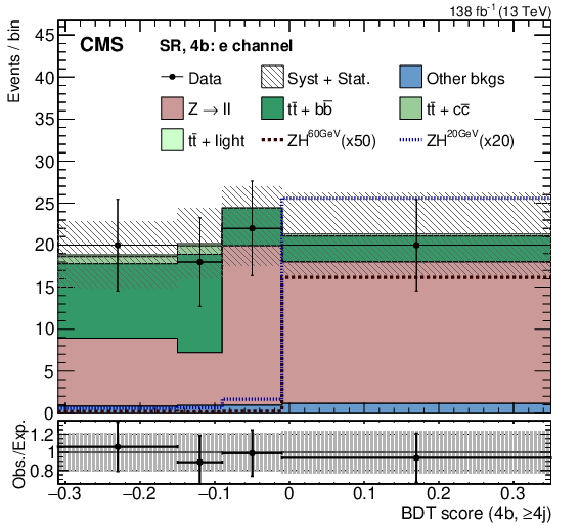
png pdf |
Figure 2-c:
Post-fit BDT distributions in the ZH channel extracted with the $ m_{\mathrm{a}}= $ 60 GeV signal hypothesis. Signal regions for the 3b (upper) and 4b (lower) event categories are shown separately for the electron (left) and muon (right) channels. The dotted lines $ \mathrm{Z}\mathrm{H}^{20\,\text{GeV}} $ and $ \mathrm{Z}\mathrm{H}^{60\,\text{GeV}} $, illustrate the shapes of the signal template normalised to the SM cross section times a branching fraction $ \mathcal{B}(\mathrm{H}\to\mathrm{a}\mathrm{a}\to\mathrm{b}\bar{\mathrm{b}}\mathrm{b}\bar{\mathrm{b}}) = $ 1 and scaled by the factors indicated in the figure. The horizontal error bars indicate the bin width. |
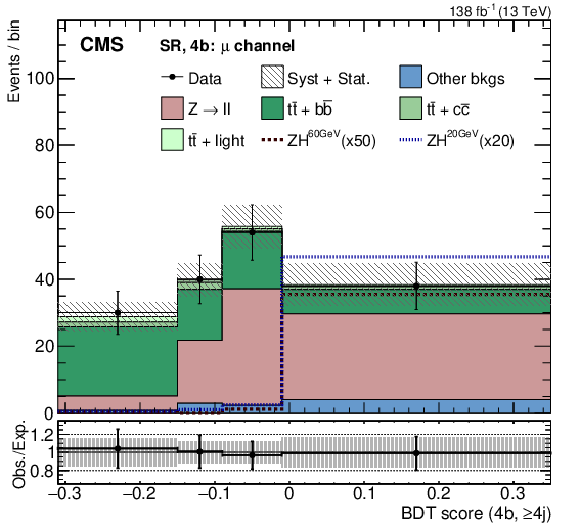
png pdf |
Figure 2-d:
Post-fit BDT distributions in the ZH channel extracted with the $ m_{\mathrm{a}}= $ 60 GeV signal hypothesis. Signal regions for the 3b (upper) and 4b (lower) event categories are shown separately for the electron (left) and muon (right) channels. The dotted lines $ \mathrm{Z}\mathrm{H}^{20\,\text{GeV}} $ and $ \mathrm{Z}\mathrm{H}^{60\,\text{GeV}} $, illustrate the shapes of the signal template normalised to the SM cross section times a branching fraction $ \mathcal{B}(\mathrm{H}\to\mathrm{a}\mathrm{a}\to\mathrm{b}\bar{\mathrm{b}}\mathrm{b}\bar{\mathrm{b}}) = $ 1 and scaled by the factors indicated in the figure. The horizontal error bars indicate the bin width. |
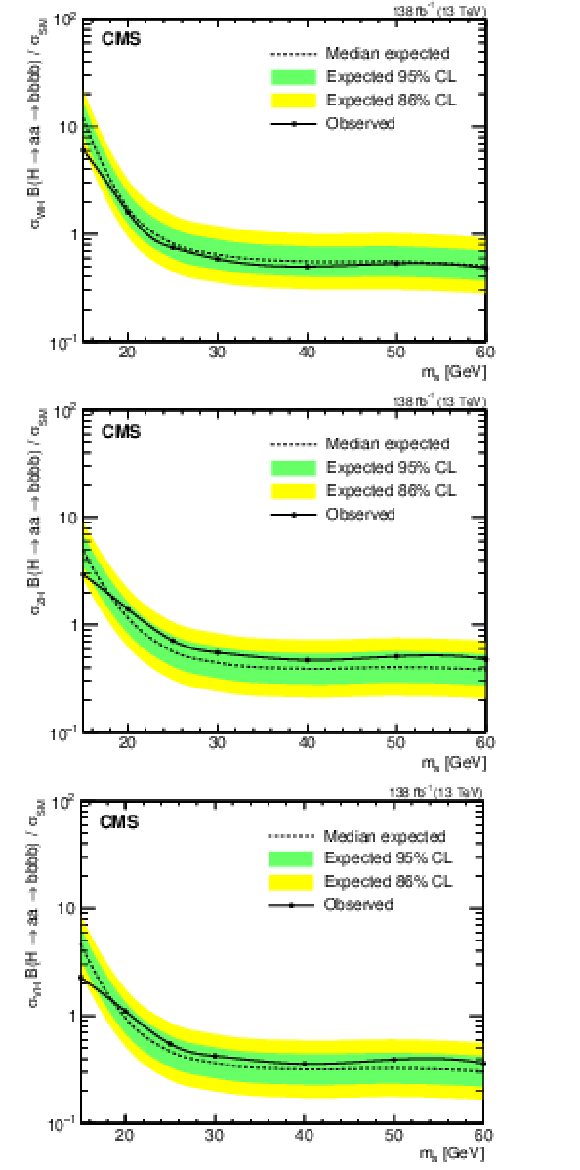
png pdf |
Figure 3:
Model independent 95% CL upper limits on $ \sigma_{\mathrm{V}\mathrm{H}} \mathcal{B}(\mathrm{H}\to\mathrm{a}\mathrm{a}\to\mathrm{b}\bar{\mathrm{b}}\mathrm{b}\bar{\mathrm{b}}) / \sigma_{\mathrm{SM}} $ for the WH channel (upper), the ZH channel (middle), and the combination of both channels (lower), where ``a'' is a new pseudoscalar particle decaying through $ \mathrm{a}\to\mathrm{b}\bar{\mathrm{b}} $, and $ \sigma_{\mathrm{SM}} $ is the SM Higgs boson production cross section. |
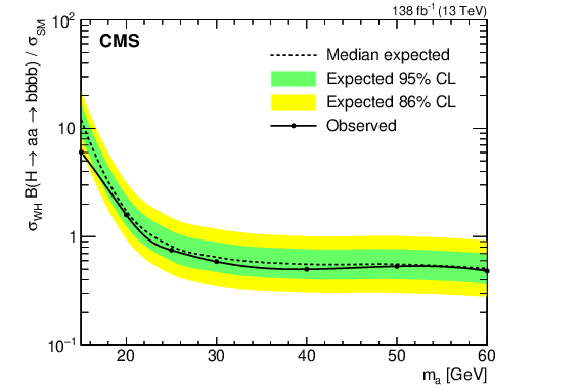
png pdf |
Figure 3-a:
Model independent 95% CL upper limits on $ \sigma_{\mathrm{V}\mathrm{H}} \mathcal{B}(\mathrm{H}\to\mathrm{a}\mathrm{a}\to\mathrm{b}\bar{\mathrm{b}}\mathrm{b}\bar{\mathrm{b}}) / \sigma_{\mathrm{SM}} $ for the WH channel (upper), the ZH channel (middle), and the combination of both channels (lower), where ``a'' is a new pseudoscalar particle decaying through $ \mathrm{a}\to\mathrm{b}\bar{\mathrm{b}} $, and $ \sigma_{\mathrm{SM}} $ is the SM Higgs boson production cross section. |
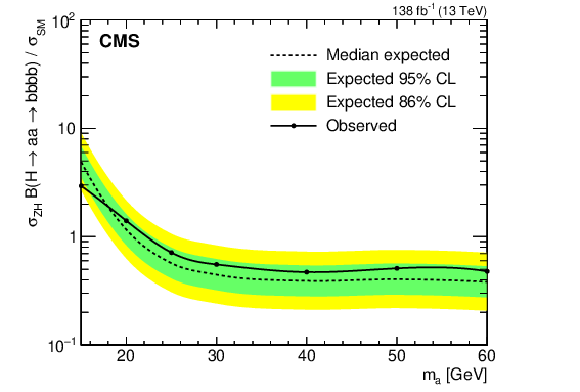
png pdf |
Figure 3-b:
Model independent 95% CL upper limits on $ \sigma_{\mathrm{V}\mathrm{H}} \mathcal{B}(\mathrm{H}\to\mathrm{a}\mathrm{a}\to\mathrm{b}\bar{\mathrm{b}}\mathrm{b}\bar{\mathrm{b}}) / \sigma_{\mathrm{SM}} $ for the WH channel (upper), the ZH channel (middle), and the combination of both channels (lower), where ``a'' is a new pseudoscalar particle decaying through $ \mathrm{a}\to\mathrm{b}\bar{\mathrm{b}} $, and $ \sigma_{\mathrm{SM}} $ is the SM Higgs boson production cross section. |
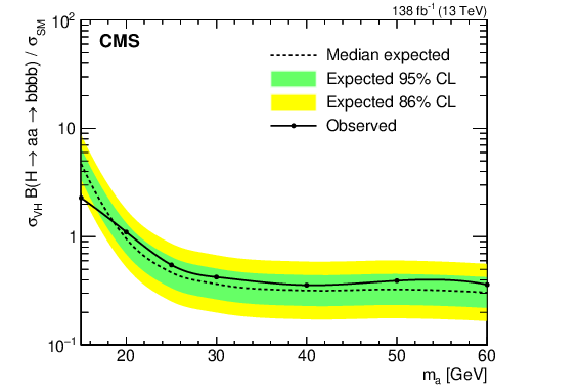
png pdf |
Figure 3-c:
Model independent 95% CL upper limits on $ \sigma_{\mathrm{V}\mathrm{H}} \mathcal{B}(\mathrm{H}\to\mathrm{a}\mathrm{a}\to\mathrm{b}\bar{\mathrm{b}}\mathrm{b}\bar{\mathrm{b}}) / \sigma_{\mathrm{SM}} $ for the WH channel (upper), the ZH channel (middle), and the combination of both channels (lower), where ``a'' is a new pseudoscalar particle decaying through $ \mathrm{a}\to\mathrm{b}\bar{\mathrm{b}} $, and $ \sigma_{\mathrm{SM}} $ is the SM Higgs boson production cross section. |
| Tables | |
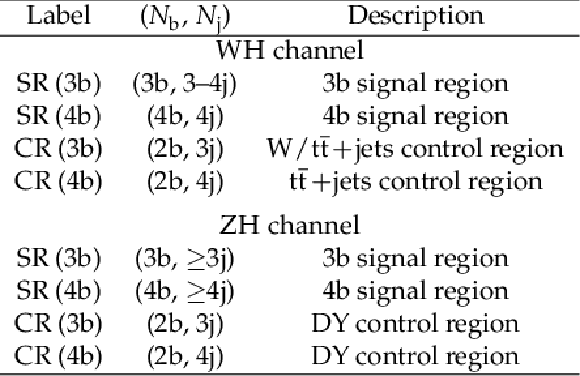
png pdf |
Table 1:
Signal region (SR) and control region (CR) requirements in ($ N_{\mathrm{b}} $, $ N_{\text{j}} $) for the WH and ZH channels, where $ N_{\mathrm{b}} $ is the number of $ \mathrm{b}\text{-tagged} $ jets in an event and $ N_{\text{j}} $ is the total number of jets in an event. |

png pdf |
Table 2:
Summary of systematic uncertainties and their effect on the background and signal event yields in the WH channel. Uncertainties that are negligible are indicated with a dash ($ \text{---} $). |

png pdf |
Table 3:
Summary of systematic uncertainties and their effect on the background and signal event yields in the ZH channel. Uncertainties that are negligible are indicated with a dash ($ \text{---} $). |
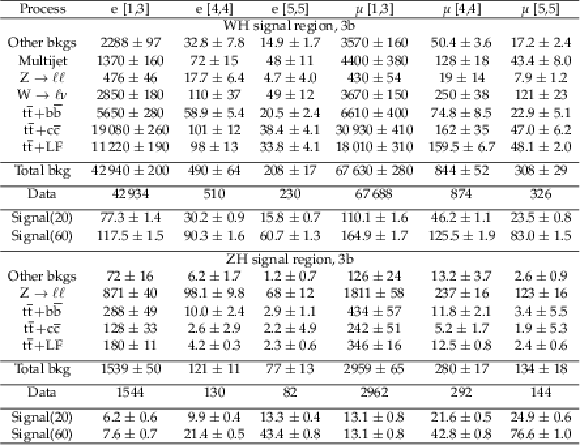
png pdf |
Table 4:
Signal-plus-background fit results for the 3b WH and ZH signal regions extracted with the $ m_{\mathrm{a}}= $ 60 GeV signal hypothesis. The lepton flavor (e or $ \mu $) and BDT bin range (in square brackets) are indicated in the column headings. Signal yields corresponding to the expectation for SM VH production and $ \mathcal{B}(\mathrm{H}\to\mathrm{a}\mathrm{a}\to\mathrm{b}\bar{\mathrm{b}}\mathrm{b}\bar{\mathrm{b}}) = $ 1 are shown for the $ m_{\mathrm{a}}= $ 20 and 60 GeV hypotheses. The background uncertainties account for both systematic and statistical sources. |
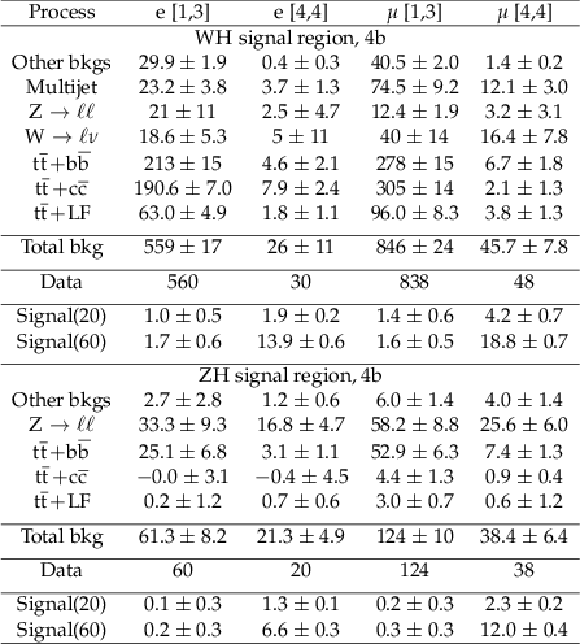
png pdf |
Table 5:
Signal-plus-background fit results for the 4b WH and ZH signal regions extracted with the $ m_{\mathrm{a}}=$ 60 GeV signal hypothesis. The lepton flavor (e or $ \mu $) and BDT bin range (in square brackets) are indicated in the column headings. Signal yields corresponding to the expectation for SM VH production and $ \mathcal{B}(\mathrm{H}\to\mathrm{a}\mathrm{a}\to\mathrm{b}\bar{\mathrm{b}}\mathrm{b}\bar{\mathrm{b}}) = $ 1 are shown for the $ m_{\mathrm{a}}= $ 20 and 60 GeV hypotheses. The background uncertainties account for both systematic and statistical sources. |
| Summary |
| A search for exotic decays of the 125 GeV Higgs boson (H) to a pair of new light pseudoscalar bosons ($ \mathrm{a} $), followed by decay to four b quark jets, $ \mathrm{H}\to\mathrm{a}\mathrm{a}\to\mathrm{b}\bar{\mathrm{b}}\mathrm{b}\bar{\mathrm{b}} $, is presented, using data recorded with the CMS detector. The analysis is based on an integrated luminosity of 138 fb$^{-1}$ collected at a center-of-mass energy of 13 TeV in 2016--2018. The search is performed in the context of the associated WH and ZH production in which the W or Z boson decays leptonically, $ \mathrm{W}\to\ell\nu $ or $ \mathrm{Z}\to\ell^+\ell^- $, with $ \ell $ an electron or muon. No evidence for the targeted decay mode is observed. The analysis obtains model independent upper limits at 95% confidence level on the branching fraction $ \mathcal{B}(\mathrm{H}\to\mathrm{a}\mathrm{a}\to\mathrm{b}\bar{\mathrm{b}}\mathrm{b}\bar{\mathrm{b}}) $ of a SM-like Higgs boson. The combined result for the associated WH and ZH Higgs boson production excludes branching fractions as low as 0.36 in the mass range $ m_{\mathrm{a}} $ between about 25 GeV and 60 GeV, assuming the SM WH and ZH cross-sections. These results provide enhanced sensitivity, in the mass range $ m_{\mathrm{a}} \gtrsim $ 20 GeV, in complementary regions of the 2HDM+S model parameter space compared to CMS searches in the $ \mu\mu\tau\tau $ and $ \mathrm{b}\mathrm{b}\ell\ell $ ($ \ell=\mu, \tau $) final states. |
| References | ||||
| 1 | ATLAS Collaboration | Observation of a new particle in the search for the standard model Higgs boson with the ATLAS detector at the LHC | PLB 716 (2012) 1 | 1207.7214 |
| 2 | CMS Collaboration | Observation of a new boson at a mass of 125 GeV with the CMS experiment at the LHC | PLB 716 (2012) 30 | CMS-HIG-12-028 1207.7235 |
| 3 | CMS Collaboration | Observation of a new boson with mass near 125 GeV in pp collisions at $ \sqrt{s} = $ 7 and 8 TeV | JHEP 06 (2013) 081 | CMS-HIG-12-036 1303.4571 |
| 4 | ATLAS Collaboration | A detailed map of Higgs boson interactions by the ATLAS experiment ten years after the discovery | Nature 607 (2022) 52 | 2207.00092 |
| 5 | CMS Collaboration | A portrait of the Higgs boson by the CMS experiment ten years after the discovery. | Nature 607 (2022) 60 | CMS-HIG-22-001 2207.00043 |
| 6 | G. C. Branco et al. | Theory and phenomenology of two-Higgs-doublet models | Phys. Rept. 516 (2012) 1 | 1106.0034 |
| 7 | D. Curtin et al. | Exotic decays of the 125 GeV Higgs boson | PRD 90 (2014) 075004 | 1312.4992 |
| 8 | U. Ellwanger, C. Hugonie, and A. M. Teixeira | The next-to-minimal supersymmetric standard model | Phys. Rept. 496 (2010) 1 | 0910.1785 |
| 9 | ATLAS Collaboration | Search for the Higgs boson produced in association with a $ W $ boson and decaying to four $ b $-quarks via two spin-zero particles in $ pp $ collisions at 13 TeV with the ATLAS detector | EPJC 76 (2016) 605 | 1606.08391 |
| 10 | ATLAS Collaboration | Search for the Higgs boson produced in association with a vector boson and decaying into two spin-zero particles in the $ H \rightarrow aa \rightarrow 4b $ channel in $ pp $ collisions at $ \sqrt{s} = $ 13 TeV with the ATLAS detector | JHEP 10 (2018) 031 | 1806.07355 |
| 11 | ATLAS Collaboration | Search for Higgs boson decays into two new low-mass spin-0 particles in the 4$ b $ channel with the ATLAS detector using $ pp $ collisions at $ \sqrt{s}= $ 13 TeV | PRD 102 (2020) 112006 | 2005.12236 |
| 12 | ATLAS Collaboration | Search for new light gauge bosons in Higgs boson decays to four-lepton final states in $ pp $ collisions at $ \sqrt{s}= $ 8 TeV with the ATLAS detector at the LHC | PRD 92 (2015) 092001 | 1505.07645 |
| 13 | CMS Collaboration | Search for a non-standard-model Higgs boson decaying to a pair of new light bosons in four-muon final states | PLB 726 (2013) 564 | CMS-EXO-12-012 1210.7619 |
| 14 | CMS Collaboration | A search for pair production of new light bosons decaying into muons | PLB 752 (2016) 146 | CMS-HIG-13-010 1506.00424 |
| 15 | CMS Collaboration | Search for light bosons in decays of the 125 GeV Higgs boson in proton-proton collisions at $ \sqrt{s}= $ 8 TeV | JHEP 10 (2017) 076 | CMS-HIG-16-015 1701.02032 |
| 16 | CMS Collaboration | Search for a very light NMSSM Higgs boson produced in decays of the 125 GeV scalar boson and decaying into $ \tau $ leptons in pp collisions at $ \sqrt{s}= $ 8 TeV | JHEP 01 (2016) 079 | CMS-HIG-14-019 1510.06534 |
| 17 | ATLAS Collaboration | Search for new phenomena in events with at least three photons collected in $ pp $ collisions at $ \sqrt{s} = $ 8 TeV with the ATLAS detector | EPJC 76 (2016) 210 | 1509.05051 |
| 18 | ATLAS Collaboration | Search for Higgs boson decays to beyond-the-standard-model light bosons in four-lepton events with the ATLAS detector at $ \sqrt{s}= $ 13 TeV | JHEP 06 (2018) 166 | 1802.03388 |
| 19 | CMS Collaboration | A search for pair production of new light bosons decaying into muons in proton-proton collisions at 13 TeV | PLB 796 (2019) 131 | CMS-HIG-18-003 1812.00380 |
| 20 | ATLAS Collaboration | Search for Higgs bosons decaying to aa in the $ \mu\mu\tau\tau $ final state in pp collisions at $ \sqrt{s} = $ 8 TeV with the ATLAS experiment | PRD 92 (2015) 052002 | 1505.01609 |
| 21 | CMS Collaboration | Search for an exotic decay of the Higgs boson to a pair of light pseudoscalars in the final state of two muons and two $ \tau $ leptons in proton-proton collisions at $ \sqrt{s}= $ 13 TeV | JHEP 11 (2018) 018 | CMS-HIG-17-029 1805.04865 |
| 22 | CMS Collaboration | Search for a light pseudoscalar Higgs boson in the boosted $ \mu\mu\tau\tau $ final state in proton-proton collisions at $ \sqrt{s}= $ 13 TeV | JHEP 08 (2020) 139 | CMS-HIG-18-024 2005.08694 |
| 23 | ATLAS Collaboration | Search for Higgs boson decays into a pair of light bosons in the $ bb\mu\mu $ final state in $ pp $ collision at $ \sqrt{s} = $ 13 TeV with the ATLAS detector | PLB 790 (2019) 1 | 1807.00539 |
| 24 | CMS Collaboration | Search for exotic decays of the Higgs boson to a pair of pseudoscalars in the $ \mu\mu $bb and $ \tau\tau $bb final states | Submitted to Eur. Phys. J. C, 2024 | CMS-HIG-22-007 2402.13358 |
| 25 | CMS Collaboration | Search for an exotic decay of the Higgs boson to a pair of light pseudoscalars in the final state with two b quarks and two $ \tau $ leptons in proton-proton collisions at $ \sqrt{s}= $ 13 TeV | PLB 785 (2018) 462 | CMS-HIG-17-024 1805.10191 |
| 26 | ATLAS Collaboration | Search for Higgs boson decays into pairs of light (pseudo)scalar particles in the $ \gamma\gamma jj $ final state in pp collisions at $ \sqrt{s}= $ 13 TeV with the ATLAS detector | PLB 782 (2018) 750 | 1803.11145 |
| 27 | M. Cepeda, S. Gori, V. M. Outschoorn, and J. Shelton | Exotic Higgs decays | Ann. Rev. Nucl. Part. Sci. 72 (2022) 119 | 2111.12751 |
| 28 | CMS Collaboration | HEPData record for this analysis | link | |
| 29 | CMS Collaboration | The CMS experiment at the CERN LHC | JINST 3 (2008) S08004 | |
| 30 | CMS Collaboration | The CMS trigger system | JINST 12 (2017) P01020 | CMS-TRG-12-001 1609.02366 |
| 31 | CMS Collaboration | Performance of the CMS level-1 trigger in proton-proton collisions at $ \sqrt{s} = $ 13 TeV | JINST 15 (2020) P10017 | CMS-TRG-17-001 2006.10165 |
| 32 | P. Nason | A new method for combining NLO QCD with shower Monte Carlo algorithms | JHEP 11 (2004) 040 | hep-ph/0409146 |
| 33 | S. Frixione, P. Nason, and C. Oleari | Matching NLO QCD computations with parton shower simulations: the POWHEG method | JHEP 11 (2007) 070 | 0709.2092 |
| 34 | S. Alioli, P. Nason, C. Oleari, and E. Re | A general framework for implementing NLO calculations in shower Monte Carlo programs: the POWHEG BOX | JHEP 06 (2010) 043 | 1002.2581 |
| 35 | CMS Collaboration | Measurement of differential cross sections for top quark pair production using the lepton+jets final state in proton-proton collisions at 13 TeV | PRD 95 (2017) 092001 | CMS-TOP-16-008 1610.04191 |
| 36 | J. Alwall et al. | The automated computation of tree-level and next-to-leading order differential cross sections, and their matching to parton shower simulations | JHEP 07 (2014) 079 | 1405.0301 |
| 37 | CMS Collaboration | Observation of Higgs boson decay to bottom quarks | PRL 121 (2018) 121801 | CMS-HIG-18-016 1808.08242 |
| 38 | J. Alwall et al. | Comparative study of various algorithms for the merging of parton showers and matrix elements in hadronic collisions | EPJC 53 (2008) 473 | 0706.2569 |
| 39 | R. Frederix and S. Frixione | Merging meets matching in MC@NLO | JHEP 12 (2012) 061 | 1209.6215 |
| 40 | LHC Higgs Cross Section Working Group | Handbook of LHC Higgs cross sections: 1. Inclusive observables | CERN Report CERN-2011-002, 2011 link |
1101.0593 |
| 41 | LHC Higgs Cross Section Working Group | Handbook of LHC Higgs cross sections: 2. Differential distributions | CERN Report CERN-2012-002, 2012 link |
1201.3084 |
| 42 | LHC Higgs Cross Section Working Group | Handbook of LHC Higgs cross sections: 3. Higgs properties | CERN Report CERN-2013-004, 2013 link |
1307.1347 |
| 43 | LHC Higgs Cross Section Working Group | Handbook of LHC Higgs cross sections: 4. deciphering the nature of the Higgs sector | CERN Report CERN-2017-002-M, 2016 link |
1610.07922 |
| 44 | NNPDF Collaboration | Parton distributions from high-precision collider data | EPJC 77 (2017) 663 | 1706.00428 |
| 45 | P. Skands, S. Carrazza, and J. Rojo | Tuning PYTHIA 8.1: the Monash 2013 Tune | EPJC 74 (2014) 3024 | 1404.5630 |
| 46 | CMS Collaboration | Event generator tunes obtained from underlying event and multiparton scattering measurements | EPJC 76 (2016) 155 | CMS-GEN-14-001 1512.00815 |
| 47 | CMS Collaboration | Extraction and validation of a new set of CMS PYTHIA8 tunes from underlying-event measurements | EPJC 80 (2020) 4 | CMS-GEN-17-001 1903.12179 |
| 48 | GEANT4 Collaboration | GEANT 4---a simulation toolkit | NIM A 506 (2003) 250 | |
| 49 | CMS Collaboration | Particle-flow reconstruction and global event description with the CMS detector | JINST 12 (2017) P10003 | CMS-PRF-14-001 1706.04965 |
| 50 | CMS Collaboration | Performance of electron reconstruction and selection with the CMS detector in proton-proton collisions at $ \sqrt{s} = $ 8 TeV | JINST 10 (2015) P06005 | CMS-EGM-13-001 1502.02701 |
| 51 | CMS Collaboration | Performance of the CMS muon detector and muon reconstruction with proton-proton collisions at $ \sqrt{s}= $ 13 TeV | JINST 13 (2018) P06015 | CMS-MUO-16-001 1804.04528 |
| 52 | CMS Collaboration | Technical proposal for the Phase-II upgrade of the Compact Muon Solenoid | CMS Technical Proposal CERN-LHCC-2015-010, CMS-TDR-15-02, 2015 CDS |
|
| 53 | M. Cacciari and G. P. Salam | Pileup subtraction using jet areas | PLB 659 (2008) 119 | 0707.1378 |
| 54 | CMS Collaboration | Measurement of the inclusive W and Z production cross sections in pp collisions at $ \sqrt{s} = $ 7 TeV | JHEP 10 (2011) 132 | CMS-EWK-10-005 1107.4789 |
| 55 | M. Cacciari, G. P. Salam, and G. Soyez | The anti-$ k_{\mathrm{T}} $ jet clustering algorithm | JHEP 04 (2008) 063 | 0802.1189 |
| 56 | M. Cacciari, G. P. Salam, and G. Soyez | FastJet user manual | EPJC 72 (2012) 1896 | 1111.6097 |
| 57 | CMS Collaboration | Jet energy scale and resolution in the CMS experiment in pp collisions at 8 TeV | JINST 12 (2017) P02014 | CMS-JME-13-004 1607.03663 |
| 58 | CMS Collaboration | Identification of heavy-flavour jets with the CMS detector in pp collisions at 13 TeV | JINST 13 (2018) P05011 | CMS-BTV-16-002 1712.07158 |
| 59 | CMS Collaboration | Performance of missing transverse momentum reconstruction in proton-proton collisions at $ \sqrt{s} = $ 13 TeV using the CMS detector | JINST 14 (2019) P07004 | CMS-JME-17-001 1903.06078 |
| 60 | UA1 Collaboration | Experimental observation of isolated large transverse energy electrons with associated missing energy at $ \sqrt{s} = $ 540 GeV | PLB 122 (1983) 103 | |
| 61 | H. Voss, A. Höcker, J. Stelzer, and F. Tegenfeldt | TMVA, the toolkit for multivariate data analysis with ROOT | in XIth International Workshop on Advanced Computing and Analysis Techniques in Physics Research (ACAT), [PoS(ACAT)040], 2007 link |
physics/0703039 |
| 62 | ATLAS Collaboration | Measurement of the $ b\overline{b} $ dijet cross section in pp collisions at $ \sqrt{s} = $ 7 TeV with the ATLAS detector | EPJC 76 (2016) 670 | 1607.08430 |
| 63 | ATLAS Collaboration | Measurement of differential production cross-sections for a $ Z $ boson in association with $ b $-jets in 7 TeV proton-proton collisions with the ATLAS detector | JHEP 10 (2014) 141 | 1407.3643 |
| 64 | CMS Collaboration | Measurement of the associated production of a Z boson with charm or bottom quark jets in proton-proton collisions at $ \sqrt {s}= $ 13 TeV | PRD 102 (2020) 032007 | CMS-SMP-19-004 2001.06899 |
| 65 | CMS Collaboration | Precision luminosity measurement in proton-proton collisions at $ \sqrt{s} = $ 13 TeV in 2015 and 2016 at CMS | EPJC 81 (2021) 800 | CMS-LUM-17-003 2104.01927 |
| 66 | CMS Collaboration | CMS luminosity measurement for the 2017 data-taking period at $ \sqrt{s} = $ 13 TeV | CMS Physics Analysis Summary, 2018 CMS-PAS-LUM-17-004 |
CMS-PAS-LUM-17-004 |
| 67 | CMS Collaboration | CMS luminosity measurement for the 2018 data-taking period at $ \sqrt{s}= $ 13 TeV | CMS Physics Analysis Summary, 2019 CMS-PAS-LUM-18-002 |
CMS-PAS-LUM-18-002 |
| 68 | J. Butterworth et al. | PDF4LHC recommendations for LHC Run II | JPG 43 (2016) 023001 | 1510.03865 |
| 69 | M. Czakon, P. Fiedler, and A. Mitov | Total top-quark pair-production cross section at hadron colliders through $ O(\alpha^4_S) $ | PRL 110 (2013) 252004 | 1303.6254 |
| 70 | N. Kidonakis | Two-loop soft anomalous dimensions for single top quark associated production with a $ W^- $ or $ H^- $ | PRD 82 (2010) 054018 | 1005.4451 |
| 71 | N. Kidonakis | Top quark production | in Helmholtz International Summer School on Physics of Heavy Quarks and Hadrons, 2014 link |
1311.0283 |
| 72 | T. Gehrmann et al. | $ W^+W^- $ production at hadron colliders in next to next to leading order QCD | PRL 113 (2014) 212001 | 1408.5243 |
| 73 | F. Cascioli et al. | ZZ production at hadron colliders in NNLO QCD | PLB 735 (2014) 311 | 1405.2219 |
| 74 | CMS Collaboration | Measurement of the differential Drell-Yan cross section in proton-proton collisions at $ \sqrt{\mathrm{s}} = $ 13 TeV | JHEP 12 (2019) 059 | CMS-SMP-17-001 1812.10529 |
| 75 | CMS Collaboration | Measurement of the inelastic proton-proton cross section at $ \sqrt{s}= $ 13 TeV | JHEP 07 (2018) 161 | CMS-FSQ-15-005 1802.02613 |
| 76 | R. J. Barlow and C. Beeston | Fitting using finite Monte Carlo samples | Comput. Phys. Commun. 77 (1993) 219 | |
| 77 | A. L. Read | Presentation of search results: The $ \text{CL}_\text{s} $ technique | JPG 28 (2002) 2693 | |
| 78 | G. Cowan, K. Cranmer, E. Gross, and O. Vitells | Asymptotic formulae for likelihood-based tests of new physics | EPJC 71 (2011) 1554 | 1007.1727 |

|
Compact Muon Solenoid LHC, CERN |

|

|

|

|

|

|